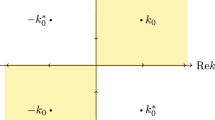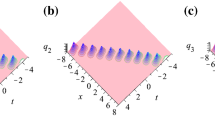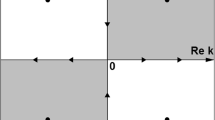Abstract
This paper is concerned with the application of the inverse scattering transforms to a third-order flow equation of nonlinear derivative Schrödinger-type equation with zero boundary conditions and double zeros of the analytic scattering coefficients. First of all, we give the third-order flow equation of nonlinear derivative Schrödinger-type equation and its Lax pair by using the zero curvature equation, which are firstly given to our knowledge. Then, in the case of double zeros for the scattering coefficient and the reflectionless, we discuss in detail the direct problem and the inverse problem of this equation, including Jost solutions, scattering coefficient, the matrix Riemann–Hilbert (RH) problem (analyticity, symmetries and asymptotic behaviors) and trace formulae. Thus, N double-pole solutions of the third-order flow equation are obtained by solving the matrix RH problem. Finally, some examples are given.


Similar content being viewed by others
Data Availability
Data sharing is not applicable to this article as no datasets were generated or analyzed during the current study.
References
Lax, P.D.: Integrals of nonlinear equations of evolution and solitary waves. Commun. Pure. Appl. Math. 21, 467–490 (1968). https://doi.org/10.1002/cpa.3160210503
Ablowitz, M.J., Fokas, A.S.: Complex Variables: Introduction and Applications. Cambridge University Press, Cambridge (2003)
Hasegawa, A., Tappert, F.: Transmission of stationary nonlinear optical pulses in dispersive dielectric fibers. I. Anomalous dispersion. Appl. Phys. Lett. 23, 142–144 (1973). https://doi.org/10.1063/1.1654836
Hasegawa, A., Kodama, Y.: Signal transmission by optical solitons in monomode fiber. In: Proceedings of the IEEE, Vol. 69, pp. 1145–1150 (1981) https://doi.org/10.1109-/PROC.1981.12129
Hasegawa, A., Kodama, Y.: Solitons in Optical communication. Oxford University Press, Oxford (1995)
Turitsyn, S.K., Prilepsky, J.E., Thai, L.S., et al.: Nonlinear Fourier transform for optical data processing and transmission: advances and perspectives. Optica 4, 307–322 (2017). https://doi.org/10.1364/OPTICA.4.000307
Biswas, A.: Stochastic perturbation of dispersion-managed optical solitons. Opt. Quant. Electron. 37, 649–659 (2005). https://doi.org/10.1007/s11082-005-5688-x
Gupta, R.K., Kumar, V., Jiwari, R.: Exact and numerical solutions of coupled short pulse equation with time-dependent coefficients. Nonlinear Dyn. 79, 455–464 (2015). https://doi.org/10.1007/s11071-014-1678-5
Agalarov, A., Zhulego, V., Gadzhimuradov, T.: Bright, dark, and mixed vector soliton solutions of the general coupled nonlinear Schrödinger equations. Phys. Rev. E 91, 042909 (2015). https://doi.org/10.1103/PhysRevE.91.042909
Jiwari, R., Kumar, S., Mittal, R.C., Awrejcewicz, J.: A meshfree approach for analysis and computational modeling of non-linear Schrödinger equation. Comput. Appl. Math. 39, 95 (2020). https://doi.org/10.1007/s40314-020-1113-0
Yadav, O.P., Jiwari, R.: Some soliton-type analytical solutions and numerical simulation of nonlinear Schrödinger equation. Nonlinear Dyn. 95, 2825–2836 (2019). https://doi.org/10.1007/s11071-018-4724-x
Novikov, S., Manakov, S.V., Pitaeskii, L.P., Zakharov, V.E.: Theory of Soliton: The Inverse Scattering Method. Springer, Berlin (1984)
Coifman, R.R., Beals, R.: Scattering and inverse scattering for first order systems. Commun. Pure Appl. Math. 37, 39–90 (1984). https://doi.org/10.1002/cpa.316
Zhang, G.Q., Yan, Z.Y.: Focusing and defocusing mKdV equations with nonzero boundary conditions: inverse scattering transforms and soliton interactions. Physica D 410, 132521 (2020). https://doi.org/10.1016/j.physd.2020.132521
Peng, W.Q., Chen, Y.: Double poles soliton solutions for the Gerdjikov–Ivanov type of derivative nonlinear schrödinger equation with zero/nonzero boundary couditions. J. Math. Phys. 63(3), 033502 (2022). https://doi.org/10.1063/5.006180710.1063/5.0061807
Zhang, G.Q., Chen, S.Y., Yan, Z.Y.: Focusing and defocusing Hirota equations with non-zero boundary conditions: Inverse scattering transforms and soliton solutions. Commun. Nonlinear Sci. Numer. Simul. 80, 104927 (2020). https://doi.org/10.1016/j.cnsns.2019.104927
Pu, J.C., Chen, Y.: Double and Triple-Pole Solutions for the third-order flow equation of the Kaup–Newell system with zero/nonzero boundary conditions. arXiv:2105.06098v3 [nlin.SI]
Zhu, J.Y., Chen, Y.: A new form of general soliton solutions and multiple zeros solutions for a higher-order Kaup–Newell equation. J. Math. Phys. 62(12), 123501 (2022). https://doi.org/10.1063/5.0064411
Zhang, G.Q., Yan, Z.Y.: The derivative nonlinear Schrödinger equation with zero/nonzero boundary conditions: inverse scattering transforms and N-double-pole solutions. J. Nonlinear Sci. 30, 3089–3127 (2020). https://doi.org/10.1007/s00332-020-09645-6
Zhang, X.F., Tian, S.F., Yang, J.J.: The Riemann–Hilbert approach for the focusing Hirota equation with single and double poles. Anal. Math. Phys. 11(86), 1–18 (2021). https://doi.org/10.1007/s13324-021-00522-3
Wadati, M., Konno, K., Ichikawa, Y.H.: A generalization of inverse scattering method. J. Phys. Soc. Jpn. 46, 1965–1966 (1979). https://doi.org/10.1143/JPSJ.46.1965
Lin, Y., Fang, Y., Dong, H.: Prolongation structures and \(N\)-soliton solutions for a new nonlinear Schrödinger-type equation via Riemann–Hilbert approach. Math. Probl. Eng. 2019, 4058041 (2019). https://doi.org/10.1155/2019/4058041
Zhang, B., Fan, E.G.: Riemann–Hilbert approach for a Schrödinger-type equation with nonzero boundary conditions. Mod. Phys. Lett. B 35(12), 2150208 (2021). https://doi.org/10.1142/S0217984921502080
Zhang, G.F., He, J.S., Cheng, Y.: Riemann–Hilbert approach and N double-pole solutions for a nonlinear Schrödinger-type equation. Chin. Phys. B 31, 110201 (2022). https://doi.org/10.1088/1674-1056/ac7a1b
Li, Y.S.: Soliton and Integrable System. Shanghai Scientific and Technological Education Publishing House, Shanghai (1999). (in Chinese)
Moses, J., Malomed, B.A., Wise, F.W.: Self-steepening of ultrashort optical pulses without self-phase-modulation. Phys. Rev. A 76, 021802 (2007). https://doi.org/10.1103/PhysRevA.76.021802
Trippenbach, M., Band, Y.B.: Effects of self-steepening and self-frequency shifting on short-pulse splitting in dispersive nonlinear media. Phys. Rev. A 57, 4791–4803 (1998). https://doi.org/10.1103/PhysRevA.57.4791
Mohamadou, A., Latchio-Tiofack, C.G., Kofane, T.C.: Wave train generation of solitons in systems with higher-order nonlinearities. Phys. Rev. E 82, 016601 (2010). https://doi.org/10.1103/PhysRevE.82.016601
Choudhuri, A., Porsezian, K.: Impact of dispersion and non-Kerr nonlinearity on the modulational instability of the higher-order nonlinear Schrödinger equation. Phys. Rev. A 85(3), 1431–1435 (2012). https://doi.org/10.1103/PhysRevA.85.033820
Renninger, W.H., Chong, A., Wise, F.W.: Dissipative solitons in normal-dispersion fiber lasers. Phys. Rev. A 77, 023814 (2008). https://doi.org/10.1103/PhysRevA.77.023814
Peng, J.S., Zhan, L., Gu, Z.C., Qian, K., Luo, S.Y., Shen, Q.S.: Experimental observation of transitions of different pulse solutions of the Ginzburg–Landau equation in a modelocked fiber laser. Phys. Rev. A 86, 033808 (2012). https://doi.org/10.1103/PhysRevA.86.033808
Akhmediev, N., Afanasjev, V.V.: Novel arbitrary-amplitude soliton solutions of the cubic-quintic complex Ginzburg–Landau equation. Phys. Rev. Lett. 75, 2320–2323 (1995). https://doi.org/10.1103/PhysRevLett.75.2320
Akhmediev, N., Afanasjev, V.V., Soto-Crespo, J.M.: Singularities and special soliton solutions of the cubic-quintic complex Ginzburg-Landau equation. Phys. Rev. E 53, 1190–1200 (1996). https://doi.org/10.1103/PhysRevE.53.1190
Soto-Crespo, J.M., Akhmediev, N., Afanasjev, V.V.: Stability of the pulselike solutions of the quintic complex Ginzburg–Landau equation. J. Opt. Soc. Am. B 13, 1439–1449 (1996). https://doi.org/10.1364/josab.13.001439
Kharif, C., Pelinovsky, E.: Physical mechanisms of the rogue wave phenomenon. Eur. J. Mech. B. Fluids 22, 603–634 (2003). https://doi.org/10.1016/j.euromechflu.2003.09.002
Ma, X.: Riemann–Hilbert approach for a higher-order Chen–Lee–Liu equation with high-order poles. Commun. Nonlinear Sci. Numer. Simul. 114, 106606 (2022). https://doi.org/10.1016/j.cnsns.2022.106606
Lin, H., He, J., Wang, L., Mihalache, D.: Several categories of exact solutions of the third-order flow equation of the Kaup–Newell system. Nonlinear Dyn. 100, 2839–2858 (2020). https://doi.org/10.1007/s11071-020-05650-2
Cheng, Q., Fan, E.: Long-time asymptotics for a mixed nonlinear Schrödinger equation with the Schwartz initial data. J. Math. Anal. Appl. 489, 124188 (2020). https://doi.org/10.1016/j.jmaa.2020.124188
Zhou, X.: Direct and inverse scattering transforms with arbitrary spectral singularities. Commun. Pure Appl. Math. 42, 895–938 (1989). https://doi.org/10.1002/cpa.3160420702
Biondini, G., Kovačič, G.: Inverse scattering transform for the focusing nonlinear Schrödinger equation with nonzero boundary conditions. J. Math. Phys. 55, 031506 (2014). https://doi.org/10.1063/1.4868483
Prinari, B., Trubatch, A.D., Feng, B.F.: Inverse scattering transform for the complex short-pulse equation by a Riemann–Hilbert approach. Eur. Phys. J. Plus 135, 1–18 (2020). https://doi.org/10.1140/epjp/s13360-020-00714-z
Zhao, Y., Fan, E.G.: Inverse scattering transformation for the fokas lenells equation with nonzero boundary conditions. J. Nonlinear Math. Phys. 28, 38–52 (2021). https://doi.org/10.2991/JNMP.K.200922.003
Weng, W., Yan, Z.: Inverse scattering and N-triple-pole soliton and breather solutions of the focusing nonlinear Schrödinger hierarchy with nonzero boundary conditions. Phys. Lett. A 407, 127472 (2021). https://doi.org/10.1016/j.physleta.2021.127472
Liu, N., Xuan, Z.X., Sun, J.Y.: Triple-pole soliton solutions of the derivative nonlinear Schrödinger equation via inverse scattering transform. Appl. Math. Lett. 125, 107741 (2022). https://doi.org/10.1016/j.aml.2021.107741
Weng, W.F., Yan, Z.Y.: The multi-triple-pole solitons for the focusing mKdV hierarchy with nonzero boundary conditions. Mod. Phys. Lett. B 35, 2150483 (2021). https://doi.org/10.1142/S0217984921504832
Wang, X.B., Han, B.: Inverse scattering transform of an extended nonlinear Schrödinger equation with nonzero boundary conditions and its multisoliton solutions. J. Math. Anal. Appl. 487(1), 123968 (2020). https://doi.org/10.1016/j.jmaa.2020.123968
Zhang, Z.Z., Fan, E.G.: Inverse scattering transform and multiple high-order pole solutions for the Gerdjikov–Ivanov equation under the zero/nonzero background. Angew. Math. Phys. 72, 153 (2021). https://doi.org/10.1007/s00033-021-01583-x
Mao, J.J., Tian, S.F., Xu, T.Z., Shi, L.F.: The bound-state soliton solutions of a higher-order nonlinear Schrödinger equation for inhomogeneous Heisenberg ferromagnetic system. Nonlinear Dyn. 104, 2639–2652 (2021). https://doi.org/10.1007/s11071-021-06425-z
Zhang, Y.S., Tao, X.X., Yao, T.T., He, J.S.: The regularity of the multiple higher-order poles solitons of the NLS equation. Stud. Appl. Math. 145, 812–827 (2020). https://doi.org/10.1111/sapm.12338
Acknowledgements
This work is supported by the National Natural Science Foundation of China (Grant Nos. 12071304 and 11871446) and the Guangdong Basic and Applied Basic Research Foundation (Grant No. 2022A15 15012554).
Funding
This work is is funded by the National Natural Science Foundation of China (Grant Nos. 12071304 and 11871446) and the Guangdong Basic and Applied Basic Research Foundation (Grant No. 2022A15 15012554).
Author information
Authors and Affiliations
Corresponding author
Ethics declarations
Conflict of interest
Authors declare that they have no conflict of interest.
Ethical approval
Authors declare that they comply with ethical standards
Additional information
Publisher's Note
Springer Nature remains neutral with regard to jurisdictional claims in published maps and institutional affiliations.
Rights and permissions
Springer Nature or its licensor (e.g. a society or other partner) holds exclusive rights to this article under a publishing agreement with the author(s) or other rightsholder(s); author self-archiving of the accepted manuscript version of this article is solely governed by the terms of such publishing agreement and applicable law.
About this article
Cite this article
Zhang, G., He, J. & Cheng, Y. Riemann–Hilbert approach and N double-pole solutions for the third-order flow equation of nonlinear derivative Schrödinger-type equation. Nonlinear Dyn 111, 6677–6687 (2023). https://doi.org/10.1007/s11071-022-08194-9
Received:
Accepted:
Published:
Issue Date:
DOI: https://doi.org/10.1007/s11071-022-08194-9




